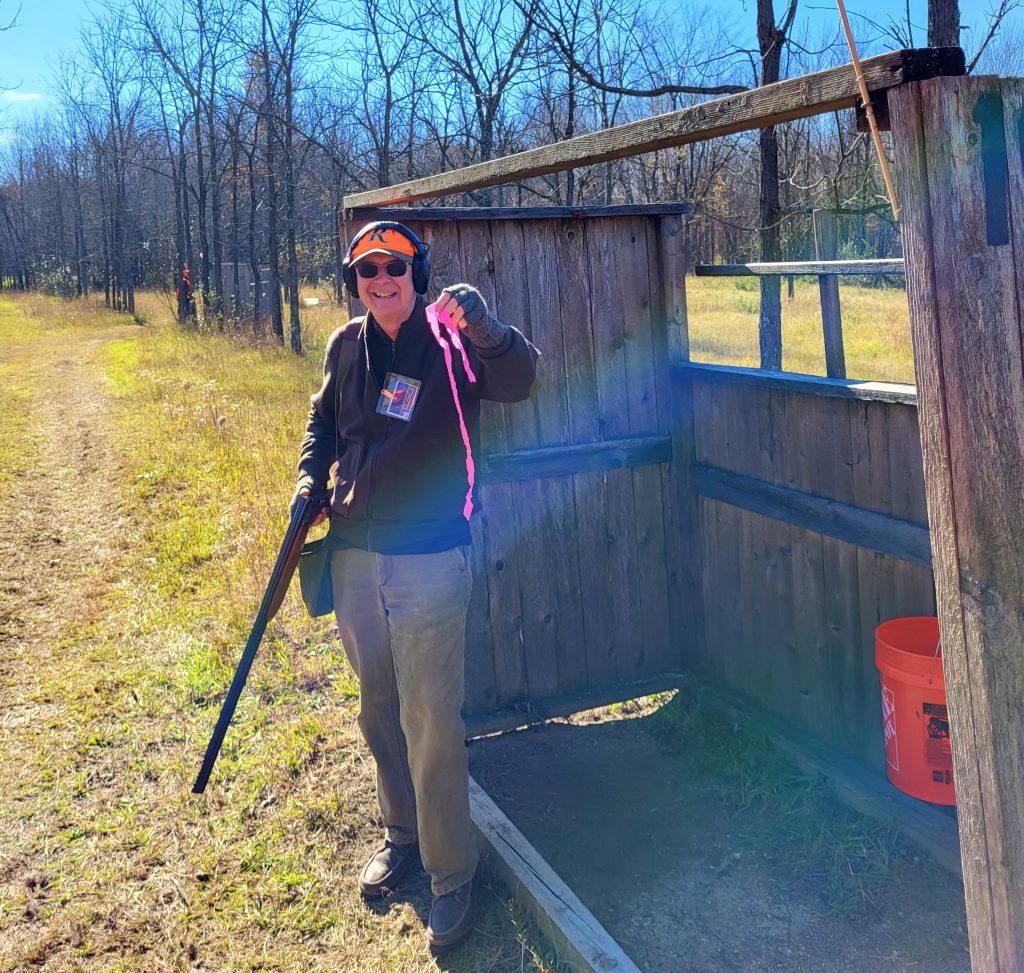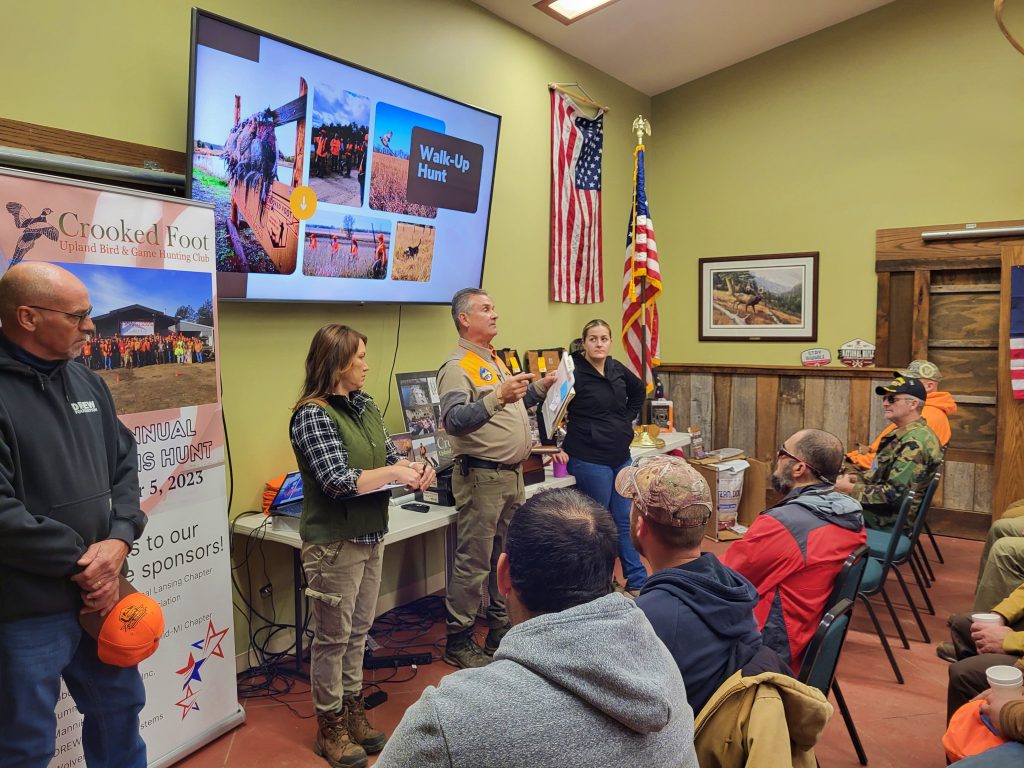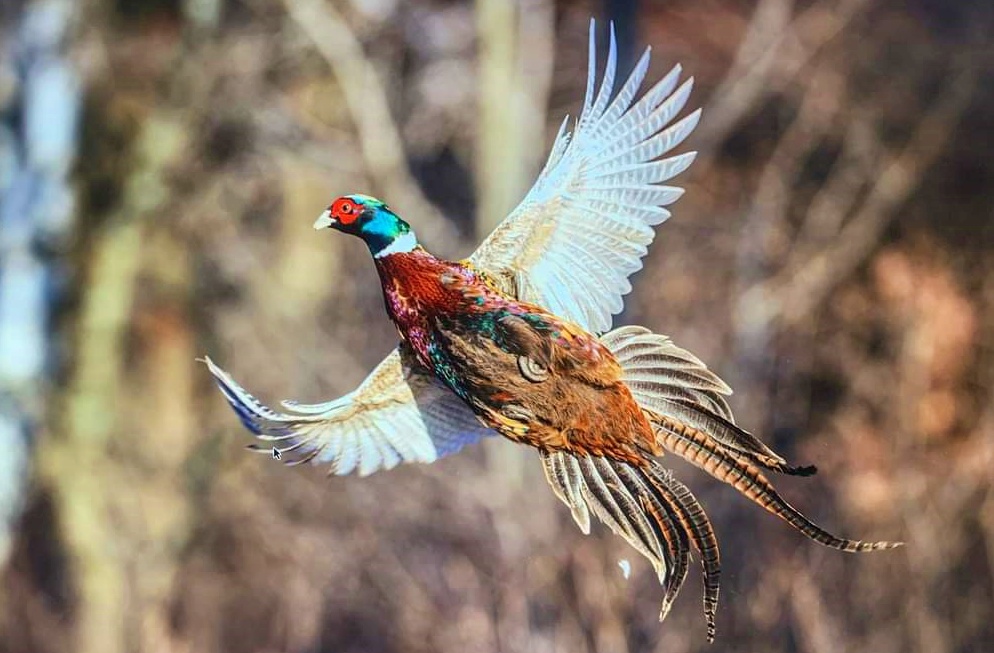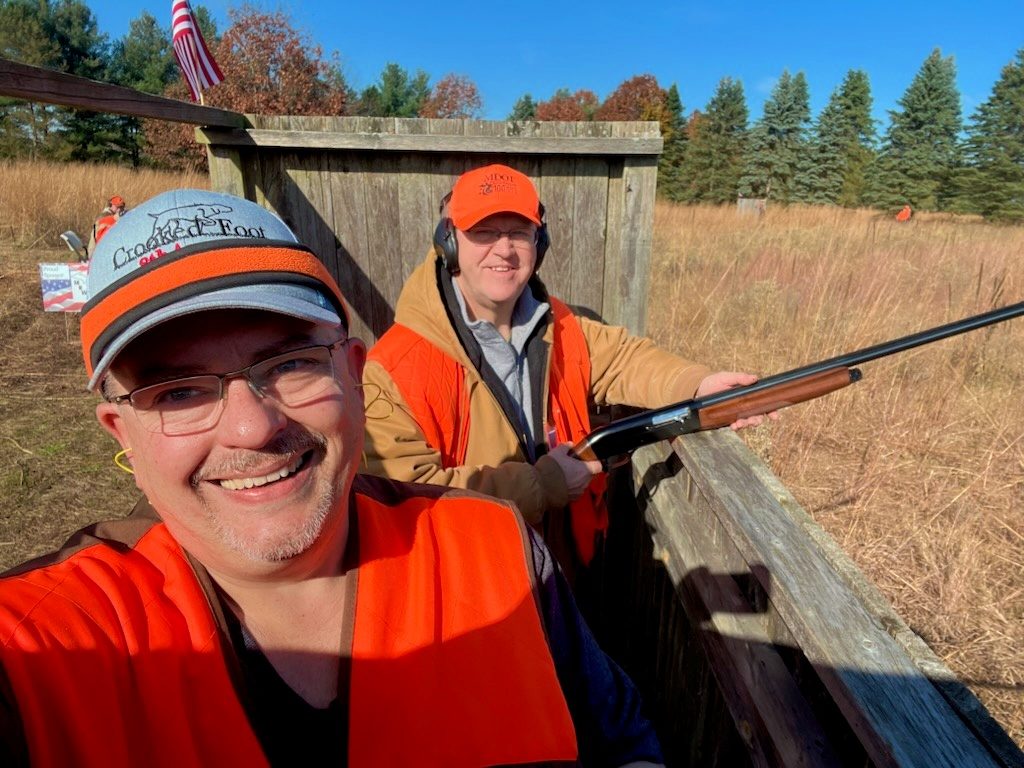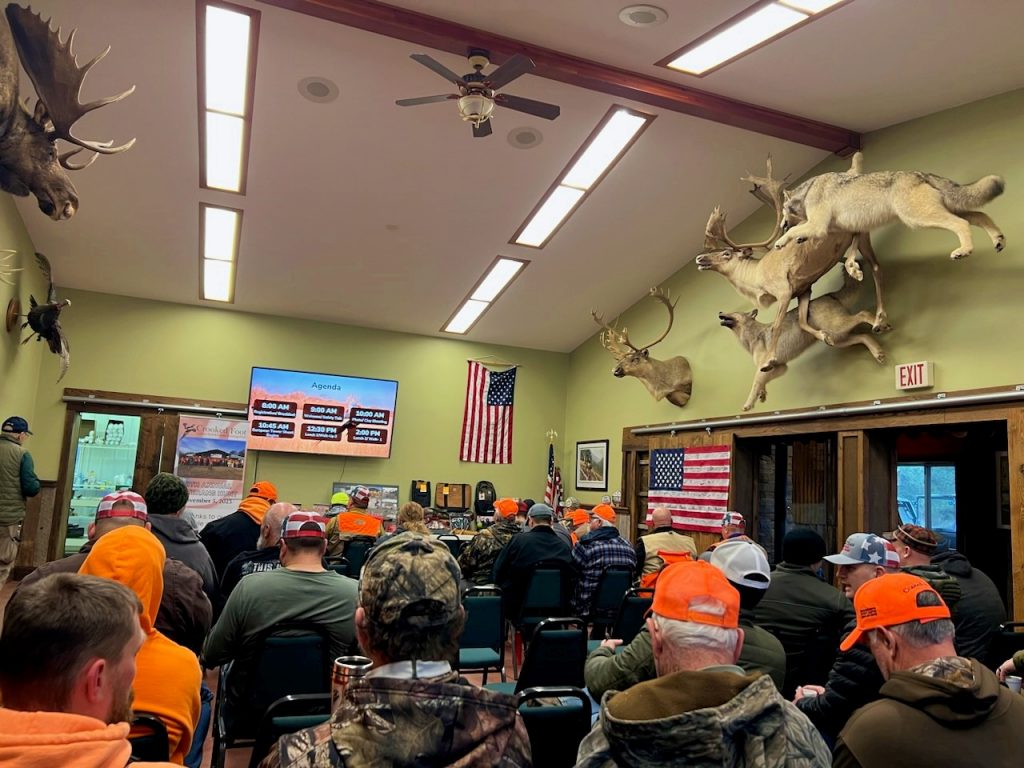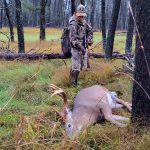Crooked Foot 2023 Veterans Hunt
by Ed H Edwards, Lansing Chapter Member, avid hunter, and fisherman
Safari Club International Lansing Chapter helped make it possible!
Pheasants departed the release tower like bees leaving their hive and flew in every direction except where I was stationed. A rooster finally veered in my direction and with gun up and hope in my heart I willed him to keep coming, and as he came into range the pink ribbon tied to his leg became visible. A prize bird!
The 8th Annual Veterans shoot at Crooked Foot was a “blast” for all. The morning started with coffee & donuts, the pledge of allegiance, raffles, a safety briefing, and an explanation of how a tower shoot is conducted.
The 90 + shooters were divided into three groups for the tower shoot with two shooters per station. A single horn blow was the notice to load up and get ready and a double blow indicated the release was over and the shooters were to unload and rotate clockwise to the next station. At the end of the shoot, every pair of shooters had shot at each station making the overall experience fair for all.
Some History on Shogun Wing Shooting.
The development leading to the modern shotguns we use nowadays came over four centuries. Fowlers of the early 16th century were not out for sport but impoverished men lugging about “small cannons” somehow acquired from conflicts with the intent of killing any edible fowl for the pot. Their shot consisted of sheets of lead chopped into small pieces that could possibly sustain a killing pattern for a very short distance. Fowl hunting at this time consisted of sitting at the edge of a pond, river, or roost and shooting hoping for the best, as hunters and gathers had been doing since the first stone was cast.
At the end of the 16 century, someone learned how to make a round shot by pouring molten lead mixed with a little arsenic through a plate pierced with holes into a bucket of water. It would be nearly 200 years before the shot tower wherein a liquid lead and antimony mix is poured through sieves, and let fall some 200 feet into large tanks of water, and the surface tension of the lead droplets in flight keeping them around.
The early fowling shotgun developed in the 1600s was a formidable weapon up to six feet long and over twenty pounds and about an 8 bore by current standards. Shooting flying fowl was still not possible, but using a blind and raking birds on the ground or water was much more successful than before but fowling as a sport for gents of leisure was still not possible.
Then came the development of the flintlock by the French, a great improvement in the refinement of a fowling piece that was much lighter and had more graceful lines. The more manageable gun made it possible to shoot flying birds and resulted in a wholesale slaughter on many of the game-rich estates. The sport of shooting flying birds in England was getting started in the same time period but without the excess practiced by the French.
Skipping to the start of the 19th century and developments made by the English using old horseshoe nails that were heated and hammered together into strips and wound around mandrels to form Damascus barrels. James Purdy and Thomas Boss built many double-barrel shotguns using Damascus steel with the weight, dimensions, and stock design popular for upland shotguns to this day.
Around 1850 the industrial revolution in England brought fortunes and the demand for fowling shotguns. Then came the desire of rich estate owners to become known for hosting driven bird shoots. Pheasants had been brought to Europe from China and like in North America were doing well, and were perfect for driven shoots. Many Lords and Earls competed to be the best not unlike professional athletes today. Rivalries were intense. Lord Walsingham had his estate driven without remorse and he shot 1,075 birds in a single day! On another shoot, Lord Wemyss in his shooting effort to be a top gun for the day continued to shoot even after setting his blind ablaze from his non-stop black powder charges. He did set a record and all three of his loaders and six shotguns got by unscathed, even though it took several days to extinguish the fire! Many estates stocked over 10,000 brass-cased shot shells and reloading gave the estate workers something to do once other chores were finished.
Driven hunts continue to be a popular shooting sport in several European countries with an emphasis on shooting high-flying birds. I had the opportunity to participate in a driven pheasant shoot in Belgium in 1985. The setup was to post the shooters at the bottom of a plateau and the pheasants would fly 35 to 45 yards over the shooters after flushed from the higher elevation.
Property size and terrain make driven hunts impractical in most of the USA and tower shoots available from clubs like Crooked Foot have become popular as an alternative setup to shoot high-flying pheasants.
Back to the Veterans Hunt
The prize rooster kept on course and rushing my 1st shot he rocked a little then folded to the 2nd!
Fellow SCI Lansing Board Member Matt De Long was shooting from another tower and also shot a prize rooster and his veteran guest Dominic won the clay bird shoot-off competition representing the Navy. My two guests were church friends Charles and Jeff and they had a great time and will try to attend the event in the future. Due to a few veterans canceling Board Member Marty Crimp and I were able to pair up and participate in the shoot and enjoyed the experience.
Approximately 900 pheasants were released giving all ample opportunities.
After the shoot, we reconvened at the clubhouse for lunch consisting of pheasant jalapeno crème cheese popper appetizers, barbecue pulled pork sandwiches, baked beans, and chips.
A great day to thank and reward our veterans for their service. Crooked Foot is a valued partner of Safari Club International Lansing Michigan Chapter and the caliber of organization we want to be associated with. The opportunity to support the Veterans Hunt using funds generated from our banquet is a worthy investment in our fight to protect hunting rights!
Join SCI TODAY!
Safari Club International is the leading voice in the fight to protect the freedom to hunt, both in the United States and internationally. The SCI Departments of Legal Advocacy Resources and International Affairs and Government Relations are headquartered in Washington, D.C., advocating on behalf of SCI members and non-members alike. From staff dedicated to legislation and policy to a team of litigators, SCI hunter advocacy is at the forefront of protecting the hunting heritage. SCI and the SCI Foundation provide the voice of the hunter in treaties that affect hunting and wildlife conservation worldwide. This is where SCI and SCI Foundation go beyond what other hunter organizations do and why their work in this arena is critical to preserving the right to hunt. Plus, we have lots of fun and events like this one!
To find out more information about SCI and join our chapter, click below:




